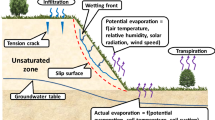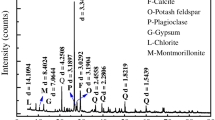Abstract
Relating porous media morphological parameters to their water retention characteristics is fundamental to develop predictive water retention models. The main objective of this study was to verify how connectivity, tortuosity, accessible porosity, and pore size distribution affect the porous media water retention characteristic. The study employed three-dimensional (3D) image analysis, obtained using X-ray computerized microtomography (μCT). The evaluation of these parameters was accomplished associating the morphological opening method to an approach proposed in this study, which we called the filling method—fiLMe. The fiLMe allows the separation of the pore system into pore diameter intervals, which is not possible with the opening method. Our results indicated that within the tension region associated with greater variation in the water retention (ranging from 2.5 to 52.5 \(cm {H}_{2}O\)—considering all porous media studied), a higher number of connected and sinuous pores was found. This means that the primary characteristic of these pores is drainage. The connectivity and tortuosity results obtained by the two methods (morphological opening and fiLMe) showed that the samples analyzed presented bottleneck characteristics in the pore space. However, the fiLMe method was faster and more versatile when compared to the morphological opening method. The 3D reconstructions of the porous medium allowed a quantitative analysis of the water retention properties of the samples investigated, enabling the observation of the regions of saturation, highest moisture content variation, and residual moisture content in the retention curves.






Similar content being viewed by others
Availability of data and material
Not applicable.
Code availability
Not applicable.
References
Borges JAR, Pires LF, Cássaro FAM et al (2019) X-ray computed tomography for assessing the effect of tillage systems on topsoil morphological attributes. Soil Tillage Res 189:25–35. https://doi.org/10.1016/j.still.2018.12.019
Borges JAR, Pires LF, Cássaro FAM et al (2018) X-ray microtomography analysis of representative elementary volume (REV) of soil morphological and geometrical properties. Soil Tillage Res 182:112–122. https://doi.org/10.1016/j.still.2018.05.004
Cássaro FAM, Pires LF, dos Santos RA et al (2009) Modified Haines’ funnel: Soil water retention curves of soil samples near saturation. Rev Bras Cienc Do Solo 32:2555–2562. https://doi.org/10.1590/s0100-06832008000600032
Cássaro FAM, Posadas Durand AN, Gimenez D, Pedro Vaz CM (2017) Pore-Size Distributions of Soils Derived using a Geometrical Approach and Multiple Resolution MicroCT Images. Soil Sci Soc Am J 81:468–476. https://doi.org/10.2136/sssaj2016.09.0291
Clennell M Ben (1997) Tortuosity: a guide through the maze. Geol Soc London, Spec Publ 122:299 LP – 344. https://doi.org/10.1144/GSL.SP.1997.122.01.18
Cunha AR, Fernandes CP, dos Santos LOE et al (2020) A phenomenological connectivity measure for the pore space of rocks. ArXiv. https://doi.org/10.48550/arXiv.2012.00835
Doube M, Klosowski MM, Arganda-Carreras I et al (2010) BoneJ: Free and extensible bone image analysis in ImageJ. Bone 47:1076–1079. https://doi.org/10.1016/j.bone.2010.08.023
Fan Z, Hu C, Zhu Q et al (2021) Three-dimensional pore characteristics and permeability properties of calcareous sand with different particle sizes. Bull Eng Geol Environ 80:2659–2670. https://doi.org/10.1007/s10064-020-02078-1
Ferreira TR, Pires LF, Wildenschild D et al (2018) X-ray microtomography analysis of lime application effects on soil porous system. Geoderma 324:119–130. https://doi.org/10.1016/j.geoderma.2018.03.015
Ferreira TR, Pires LF, Wildenschild D et al (2019) Lime application effects on soil aggregate properties: Use of the mean weight diameter and synchrotron-based X-ray μCT techniques. Geoderma 338:585–596. https://doi.org/10.1016/j.geoderma.2018.10.035
Fu J, Thomas HR, Li C (2021) Tortuosity of porous media: image analysis and physical simulation. Earth-Science Rev 212:103439
Galdos MV, Brown E, Rosolem CA et al (2020) Brachiaria species influence nitrate transport in soil by modifying soil structure with their root system. Sci Rep 10:1–11. https://doi.org/10.1038/s41598-020-61986-0
Galdos MV, Pires LF, Cooper HV et al (2019) Assessing the long-term effects of zero-tillage on the macroporosity of Brazilian soils using X-ray Computed Tomography. Geoderma 337:1126–1135. https://doi.org/10.1016/j.geoderma.2018.11.031
Guber A, Kutlu T, Rivers M, Kravchenko A (2021) Mass-balance approach to quantify water distribution in soils based on X-ray computed tomography images. Eur J Soil Sci 72:578–592. https://doi.org/10.1111/ejss.13005
Hajnos M, Lipiec J, Świeboda R et al (2006) Complete characterization of pore size distribution of tilled and orchard soil using water retention curve, mercury porosimetry, nitrogen adsorption, and water desorption methods. Geoderma 135:307–314. https://doi.org/10.1016/j.geoderma.2006.01.010
Hillel D (1998) Environmental Soil Physics: Fundamentals, Applications, and Environmental Considerations. Academic Press, Massachusetts
Houston AN, Otten W, Falconer R et al (2017) Quantification of the pore size distribution of soils: Assessment of existing software using tomographic and synthetic 3D images. Geoderma 299:73–82. https://doi.org/10.1016/j.geoderma.2017.03.025
Juyal A, Eickhorst T, Falconer R, et al (2018) Control of Pore Geometry in Soil Microcosms and Its Effect on the Growth and Spread of Pseudomonas and Bacillus sp. Front Environ Sci 6.https://doi.org/10.3389/fenvs.2018.00073
Katuwal S, Norgaard T, Moldrup P et al (2015) Linking air and water transport in intact soils to macropore characteristics inferred from X-ray computed tomography. Geoderma 237–238:9–20. https://doi.org/10.1016/j.geoderma.2014.08.006
Koestel J, Fukumasu J, Garland G et al (2021) Approaches to delineate aggregates in intact soil using X-ray imaging. Geoderma 402:115360. https://doi.org/10.1016/j.geoderma.2021.115360
Kravchenko AN, Negassa WC, Guber AK, Rivers ML (2015) Protection of soil carbon within macro-aggregates depends on intra-aggregate pore characteristics. Sci Rep 5:16261. https://doi.org/10.1038/srep16261
Legland D, Arganda-Carreras I, Andrey P (2016) MorphoLibJ: integrated library and plugins for mathematical morphology with ImageJ. Bioinformatics 32:3532–3534. https://doi.org/10.1093/bioinformatics/btw413
Leue M, Uteau-Puschmann D, Peth S et al (2019) Separation of Soil Macropore Types in Three-Dimensional X-Ray Computed Tomography Images Based on Pore Geometry Characteristics. Vadose Zo J 18:1–13. https://doi.org/10.2136/vzj2018.09.0170
Lipiec J, Hajnos M, Świeboda R (2012) Estimating effects of compaction on pore size distribution of soil aggregates by mercury porosimeter. Geoderma 179–180:20–27. https://doi.org/10.1016/j.geoderma.2012.02.014
Liu X, Zhou A, Li J, Feng S (2020) Reproducing micro X-ray computed tomography (microXCT) observations of air–water distribution in porous media using revised pore-morphology method. Can Geotech J 57:149–156. https://doi.org/10.1139/cgj-2018-0662
Mady AY, Shein E (2018) Modelling and validation hysteresis in soil water retention curve using tomography of pore structure. Int J Water 12:370–381. https://doi.org/10.1504/IJW.2018.095403
Münch B, Holzer L (2008) Contradicting Geometrical Concepts in Pore Size Analysis Attained with Electron Microscopy and Mercury Intrusion. J Am Ceram Soc 91:4059–4067. https://doi.org/10.1111/j.1551-2916.2008.02736.x
Ngom NF, Garnier P, Monga O, Peth S (2011) Extraction of three-dimensional soil pore space from microtomography images using a geometrical approach. Geoderma 163:127–134. https://doi.org/10.1016/j.geoderma.2011.04.013
Oliveira JAT, Cássaro FAM, Pires LF (2020) The porous size distribution obtained and analyzed by free access software. Rev Bras Ensino Fis 42.https://doi.org/10.1590/1806-9126-RBEF-20200192
Oliveira JAT, Cássaro FAM, Pires LF (2021) Estimating soil porosity and pore size distribution changes due to wetting-drying cycles by morphometric image analysis. Soil Tillage Res 205:104814. https://doi.org/10.1016/j.still.2020.104814
Park J, Hyun C-U, Park H-D (2015) Changes in microstructure and physical properties of rocks caused by artificial freeze–thaw action. Bull Eng Geol Environ 74:555–565. https://doi.org/10.1007/s10064-014-0630-8
Pires LF, Borges JAR, Rosa JA et al (2017) Soil structure changes induced by tillage systems. Soil Tillage Res 165:66–79. https://doi.org/10.1016/j.still.2016.07.010
Pires LF, Roque WL, Rosa JA, Mooney SJ (2019) 3D analysis of the soil porous architecture under long term contrasting management systems by X-ray computed tomography. Soil Tillage Res 191:197–206. https://doi.org/10.1016/j.still.2019.02.018
Rab MA, Haling RE, Aarons SR et al (2014) Evaluation of X-ray computed tomography for quantifying macroporosity of loamy pasture soils. Geoderma 213:460–470. https://doi.org/10.1016/j.geoderma.2013.08.037
dos Reis AMH, Auler AC, Armindo RA et al (2021) Micromorphological analysis of soil porosity under integrated crop-livestock management systems. Soil Tillage Res 205:104783. https://doi.org/10.1016/j.still.2020.104783
Ridler TW, Calvard S (1978) Picture Thresholding Using an Iterative Slection Method. IEEE Trans Syst Man Cybern SMC 8:630–632. https://doi.org/10.1109/tsmc.1978.4310039
Roque WL, Costa RRA (2020) A plugin for computing the pore/grain network tortuosity of a porous medium from 2D/3D MicroCT image. Appl Comput Geosci 5:100019. https://doi.org/10.1016/j.acags.2020.100019
Schlüter S, Vogel H-J (2016) Analysis of Soil Structure Turnover with Garnet Particles and X-Ray Microtomography. PLoS One 11:e0159948. https://doi.org/10.1371/journal.pone.0159948
Schneider CA, Rasband WS, Eliceiri KW (2012) NIH Image to ImageJ: 25 years of image analysis. Nat Methods 9:671–675
Shou YD, Zhao Z, Zhou XP (2020) Sensitivity analysis of segmentation techniques and voxel resolution on rock physical properties by X-ray imaging. J Struct Geol 133:103978. https://doi.org/10.1016/j.jsg.2020.103978
da Silva TS, Pulido-Moncada M, Schmidt MR et al (2021) Soil pore characteristics and gas transport properties of a no-tillage system in a subtropical climate. Geoderma 401:115222. https://doi.org/10.1016/j.geoderma.2021.115222
Singh J, Singh N, Kumar S (2020) X-ray computed tomography–measured soil pore parameters as influenced by crop rotations and cover crops. Soil Sci Soc Am J 84:1267–1279. https://doi.org/10.1002/saj2.20105
Song S, Ding Q, Wei J (2019) Improved algorithm for estimating pore size distribution from pore space images of porous media. Phys Rev E 100:053314. https://doi.org/10.1103/PhysRevE.100.053314
Toriwaki J, Yonekura T (2002) Euler number and connectivity indexes of a three dimensional digital picture. Forma-Tokyo- 17:183–209
Tseng CL, Alves MC, Crestana S (2018) Quantifying physical and structural soil properties using X-ray microtomography. Geoderma 318:78–87. https://doi.org/10.1016/j.geoderma.2017.11.042
Vaz CMP, de Maria IC, Lasso PO, Tuller M (2011) Evaluation of an Advanced Benchtop Micro-Computed Tomography System for Quantifying Porosities and Pore-Size Distributions of Two Brazilian Oxisols. Soil Sci Soc Am J 75:832–841. https://doi.org/10.2136/sssaj2010.0245
Vogel HJ (1997) Morphological determination of pore connectivity as a function of pore size using serial sections. Eur J Soil Sci 48:365–377. https://doi.org/10.1111/j.1365-2389.1997.tb00203.x
Vogel HJ, Kretzschmar A (1996) Topological characterization of pore space in soil - Sample preparation and digital image-processing. Geoderma 73:23–38. https://doi.org/10.1016/0016-7061(96)00043-2
Xiaoqin S, Dongli S, Yuanhang F et al (2021) Three-dimensional fractal characteristics of soil pore structure and their relationships with hydraulic parameters in biochar-amended saline soil. Soil Tillage Res 205:104809. https://doi.org/10.1016/j.still.2020.104809
Yu H, Lu C, Chen W, Li H (2021) Permeability changes in fractured Tamusu mudstone in the context of radioactive waste disposal. Bull Eng Geol Environ 80:7945–7957. https://doi.org/10.1007/s10064-021-02445-6
Zhou H, Fang H, Mooney SJ, Peng X (2016) Effects of long-term inorganic and organic fertilizations on the soil micro and macro structures of rice paddies. Geoderma 266:66–74. https://doi.org/10.1016/j.geoderma.2015.12.007
Acknowledgements
The authors would like to thank Dr. J.A.T. de Oliveira for his contribution to the acquisition of experimental data, Dr. W.L. Roque for clarifying the Tortuosity used plugin, and Dr. C.M.P. Vaz for making available the tomographic system and his lab infrastructure for the analysis of the samples. L.F. Pires thanks the financial support of the National Council for Scientific and Technological Development (CNPq) for the research productivity grant (process no. 304925/2019-5).
Author information
Authors and Affiliations
Contributions
M.A. Camargo: Investigation, methodology, conceptualization, writing—original draft. F.A.M. Cássaro: Methodology, conceptualization, writing—review and editing. L.F. Pires: Methodology, conceptualization, writing—review and editing—resources.
Corresponding author
Ethics declarations
Conflict of interest
The authors declare no competing interests.
Supplementary Information
Below is the link to the electronic supplementary material.
Rights and permissions
About this article
Cite this article
Camargo, M.A., Cássaro, F.A.M. & Pires, L.F. How do geometric factors influence soil water retention? A study using computerized microtomography. Bull Eng Geol Environ 81, 137 (2022). https://doi.org/10.1007/s10064-022-02632-z
Received:
Accepted:
Published:
DOI: https://doi.org/10.1007/s10064-022-02632-z




